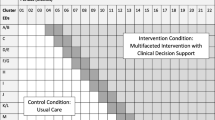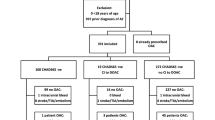Abstract
Objectives
Acute atrial fibrillation (AF)/flutter (AFL) is a common emergency department (ED) presentation. In 2021, an updated version of CAEP’s Acute AF/AFL Best Practices Checklist was published, seeking to guide management. We assessed the alignment with and safety of application of the Checklist, regarding stroke prevention and disposition.
Methods
This health records review included adults presenting to two tertiary care academic EDs between January and August 2022 with a diagnosis of acute AF/AFL. Patients were excluded if their initial heart rate was < 100 or if they were hospitalized. Data extracted included: demographics, CHADS-65 score, clinical characteristics, ED treatment and disposition, and outpatient prescriptions and referrals. Our primary outcome was the proportion of patient encounters with one or more identified safety issues. Each case was assessed according to seven predetermined criteria from elements of the CAEP Checklist and either deemed “safe” or to contain one or more safety issues. We used descriptive statistics with 95% confidence intervals.
Results
358 patients met inclusion criteria. The mean age was 66.9 years, 59.2% were male and 77.4% patients had at least one of the CHADS-65 criteria. 169 (47.2%) were not already on anticoagulation and 99 (27.6%) were discharged home with a new prescription for anticoagulation. The primary outcome was identified in 6.4% (95% CI 4.3–9.5) of encounters, representing 28 safety issues in 23 individuals. The safety concerns included: failure to prescribe anticoagulation when indicated (n = 6), inappropriate dosing of a direct oral anticoagulant (DOAC) (n = 2), inappropriate prescription of rate or rhythm control medication (n = 9), and failure to recommend appropriately timed follow-up for new rate control medication (n = 11).
Conclusions
There was a very high level of ED physician alignment with CAEP’s Best Practices Checklist regarding disposition and stroke prevention. There are opportunities to further improve care with respect to recommendation of anticoagulation and reducing inappropriate prescriptions of rate or rhythm medications.
Résumé
Objectifs
La fibrillation auriculaire aiguë (FA)/flutter (FAT) est une présentation courante aux urgences (SU). En 2021, une version mise à jour de la liste de vérification des pratiques exemplaires en matière de FA/FAT aiguë du CAEP a été publiée, dans le but de guider la direction. Nous avons évalué l’harmonisation et la sécurité de l’application de la liste de contrôle en ce qui concerne la prévention et la disposition des AVC.
Méthodes
Cet examen des dossiers de santé comprenait des adultes qui se sont présentés à deux urgences universitaires de soins tertiaires entre janvier et août 2022 avec un diagnostic d’AF/AFL aigu. Les patients étaient exclus si leur fréquence cardiaque initiale était inférieure à 100 ou s’ils étaient hospitalisés. Les données extraites comprenaient les données démographiques, le score CHADS-65, les caractéristiques cliniques, le traitement et la disposition des urgences, ainsi que les prescriptions et les références ambulatoires. Notre résultat principal était la proportion de patients qui rencontraient un ou plusieurs problèmes de sécurité identifiés. Chaque cas a été évalué selon sept critères prédéterminés à partir des éléments de la liste de vérification du PPVE et jugé « sécuritaire » ou comportant un ou plusieurs problèmes de sécurité. Nous avons utilisé des statistiques descriptives avec des intervalles de confiance de 95 %.
Résultats
358 patients répondaient aux critères d’inclusion. L’âge moyen était de 66.9 ans, 59.2% étaient des hommes et 77.4% des patients avaient au moins un des critères CHADS-65. 169 (47.2%) n’étaient pas déjà sous anticoagulation et 99 (27.6%) ont été renvoyés à la maison avec une nouvelle prescription d’anticoagulation. Le critère de jugement principal a été identifié dans 6.4 % (IC à 95 % 4.3–9.5) des rencontres, ce qui représente 28 problèmes d’innocuité chez 23 personnes. Parmi les préoccupations en matière d’innocuité, mentionnons l’omission de prescrire un anticoagulant lorsque cela est indiqué (n = 6), l’administration inappropriée d’un anticoagulant oral direct (n = 2), la prescription inappropriée d’un médicament pour contrôler le rythme ou le rythme (n = 9), et l’omission de recommander un suivi bien chronométré vers le haut pour le nouveau médicament de contrôle de taux (n = 11).
Conclusions
Il y avait un très haut niveau d’harmonisation des médecins de l’urgence avec la liste de vérification des pratiques exemplaires de l’ACMU en ce qui concerne la disposition et la prévention des accidents vasculaires cérébraux. Il est possible d’améliorer davantage les soins en ce qui concerne la recommandation d’anticoagulation et de réduire les prescriptions inappropriées de médicaments à taux ou à rythme.
Similar content being viewed by others
Data availability
Data available within the article or its supplementary materials.
References
Rogenstein C, Kelly AM, Mason S, Schneider S, Lang E, Clement CM, et al. An international view of how recent-onset atrial fibrillation is treated in the emergency department. Acad Emerg Med. 2012;19(11):1255–60.
Stiell IG, Clement CM, Brison RJ, Rowe BH, Borgundvaag B, Langhan T, et al. Variation in management of recent-onset atrial fibrillation and flutter among academic hospital emergency departments. Ann Emerg Med. 2011;57(1):13–21.
Stiell IG, de Wit K, Scheuermeyer FX, Vadeboncoeur A, Angaran P, Eagles D, et al. 2021 CAEP acute atrial fibrillation/flutter best practices checklist. Can J Emerg Med. 2021;23(5):604–10.
Stiell IG, Sivilotti MLA, Taljaard M, Birnie D, Vadeboncoeur A, Hohl CM, et al. Electrical versus pharmacological cardioversion for emergency department patients with acute atrial fibrillation (RAFF2): a partial factorial randomised trial. Lancet. 2020;395(10221):339–49.
Gebreyohannes EA, Salter S, Chalmers L, Bereznicki L, Lee K. Non-adherence to thromboprophylaxis guidelines in atrial fibrillation: a narrative review of the extent of and factors in guideline non-adherence. Am J Cardiovasc Drugs. 2021;21(4):419–33.
Mattice AMS, Adler S, Eagles D, Yadav K, Hui S, Azward A, Pandey N, Stiell IG. Assessment of physician compliance to the CAEP 2021 Atrial Fibrillation Best Practices Checklist for rate and rhythm control in the emergency department. Can J Emerg Med. 2024. https://doi.org/10.1007/s43678-024-00669-5
Hart RG, Pearce LA, Aguilar MI. Meta-analysis: antithrombotic therapy to prevent stroke in patients who have nonvalvular atrial fibrillation. Ann Intern Med. 2007;146(12):857–67.
Atzema CL, Jackevicius CA, Chong A, Dorian P, Ivers NM, Parkash R, et al. Prescribing of oral anticoagulants in the emergency department and subsequent long-term use by older adults with atrial fibrillation. CMAJ. 2019;191(49):E1345–54.
Andrade JG, Aguilar M, Atzema C, Bell A, Cairns JA, Cheung CC, et al. The 2020 Canadian Cardiovascular Society/Canadian Heart Rhythm Society Comprehensive Guidelines for the Management of Atrial Fibrillation. Can J Cardiol. 2020;36(12):1847–948.
Masica A, Brown R, Farzad A, Garrett JS, Wheelan K, Nguyen HL, et al. Effectiveness of an algorithm-based care pathway for patients with non-valvular atrial fibrillation presenting to the emergency department. J Am Coll Emerg Physicians Open. 2022;3(1): e12608.
Author information
Authors and Affiliations
Corresponding author
Ethics declarations
Conflict of interest
None.
Supplementary Information
Below is the link to the electronic supplementary material.
Rights and permissions
Springer Nature or its licensor (e.g. a society or other partner) holds exclusive rights to this article under a publishing agreement with the author(s) or other rightsholder(s); author self-archiving of the accepted manuscript version of this article is solely governed by the terms of such publishing agreement and applicable law.
About this article
Cite this article
Adler, S., Mattice, A.M.S., Eagles, D. et al. How well do ED physician practices align with the CAEP acute atrial fibrillation checklist for stroke prevention and disposition?. Can J Emerg Med (2024). https://doi.org/10.1007/s43678-024-00676-6
Received:
Accepted:
Published:
DOI: https://doi.org/10.1007/s43678-024-00676-6




